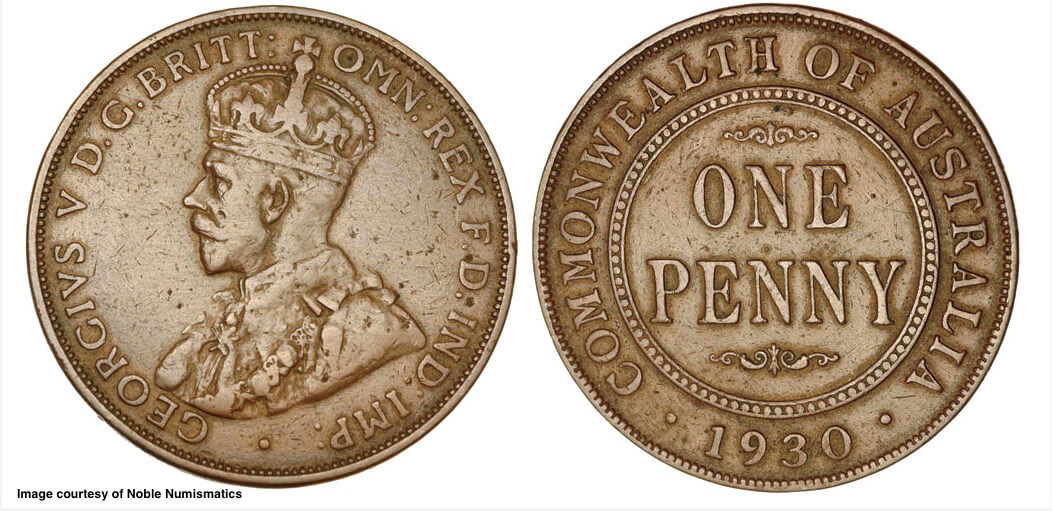The 1930 Penny With The London Obverse - Australia's Rarest Circulating Coin
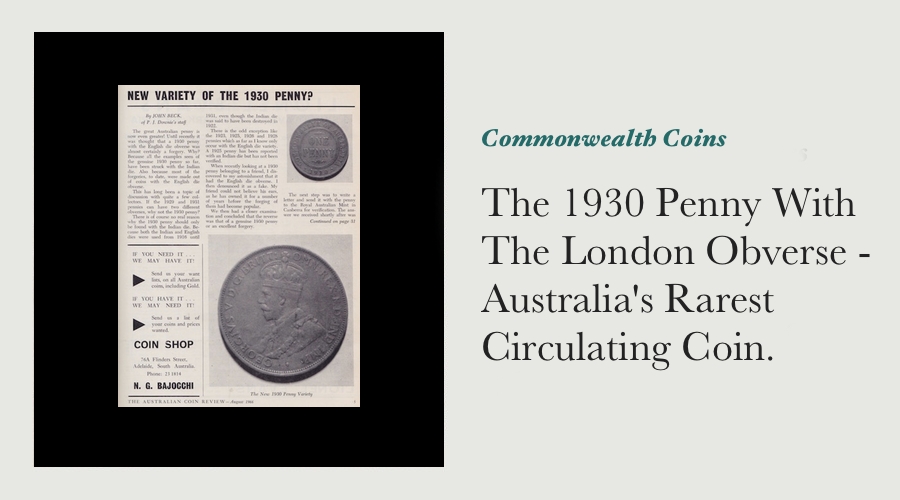
Very few collectors are aware there are actually two different types of Australian 1930 penny, and while both types are rare, one is exponentially rarer than the other. The two different types are referred to as having either the “Indian obverse” or the “London obverse”. 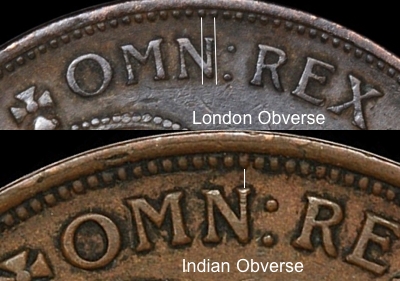
Each type is named for the master tools used to create the dies from which the coins were struck. Pennies with the London obverse were struck from dies derived from master tools created by the Royal Mint in London, while Indian obverse pennies were struck from dies derived from master tools created by the Calcutta branch of the Royal Mint.
Nearly all 1930 pennies have the Indian obverse, those with the London obverse are incredibly rare. They are so rare in fact that most collectors will immediately disregard an unknown 1930 penny with the London obverse, as ordinarily, it is well known to be a clear sign the coin is a date-altered counterfeit.
Struck During An Experiment on August 13th, 1931
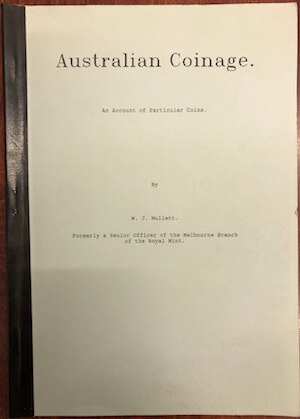 1930 pennies were struck on 2 separate occasions - on August 13th 1930, when a small batch was struck as proofs/specimens of record, and a further batch on August 13th 1931, as part of experiments that tested different pairs of obverse and reverse dies.
1930 pennies were struck on 2 separate occasions - on August 13th 1930, when a small batch was struck as proofs/specimens of record, and a further batch on August 13th 1931, as part of experiments that tested different pairs of obverse and reverse dies.
The 1930 pennies with the London obverse were struck as part of the experiments conducted on August 13th, 1931.
Bill Mullett was on staff at both the Melbourne and Royal Australian Mints, research by him into the die records of the Melbourne Mint, published in his book "Australian Coinage - An Account of Particular Coins”, noted the exact dies that were used to strike the 1930 pennies with the London obverse.
The obverse die used was Number 78 off the hub labelled A2E1921, while the reverse die was either labelled S75 or S76.
Example #1: Church - First Mentioned in 1966, Rediscovered in 2020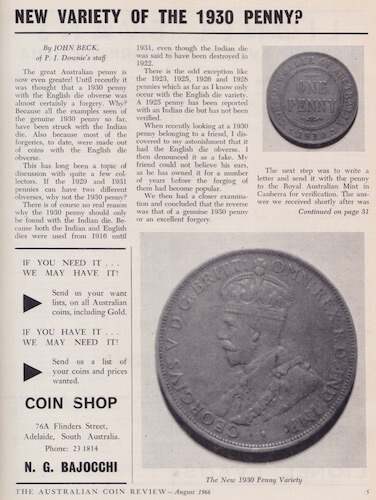
The earliest published reference to the existence of the 1930 penny was in 1940 when Fritz Schafer advised Syd Hagley that he had located two Australian 1930 pennies from circulation[1].
The 1930 penny with the London obverse is not mentioned in print for another 26 years when an article written by John Beck was published in the August 1966 edition of the Australian Coin Review magazine.
In the article, Beck described how he’d examined the 1930 penny owned by his friend (and work colleague) Stan Church. Beck stated that although at first he thought the coin was counterfeit, once he examined it in detail he considered it could well be genuine.
“When recently looking at a 1930 penny belonging to a friend, I discovered to my astonishment that it had the English die obverse. I then denounced it as a fake. My friend could not believe his ears, as he has owned it for a number of years before the forging of them had become popular. We then had a closer examination and concluded that the reverse was that of a genuine 1930 penny - or an excellent forgery. The next step was to write a letter and send it with the penny to the Royal Australian Mint in Canberra for verification. The answer we received shortly after was that the penny was genuine[2].”
An editorial comment following Beck’s article was rather reserved: “As the Editorial staff of Coin Review did not have the opportunity to study the 1930 penny described in this article before it was auctioned recently, we can merely reproduce the article without comment. However, we have seen the letter from the Royal Australian Mint, and cannot but treat this matter with serious regard.”
The reason for that reserve may have been a qualifying comment by the Deputy Master of the Royal Australian Mint in his authentication report: “We do not have X-ray facilities at the Mint so that our testing falls short of the certainty provided by this method.”
In an address to the Numismatic Association of Victoria in 1966 (subsequently published in the September 1966 edition of the Australian Coin Review Magazine), Phil Downie recounted the circumstances leading up to the attribution of the Church 1930 penny.
In the following passage, Downie describes the auction the coin was offered in:
“May '66: F, £ 230, abt. VF, £ 280, Record. For this sale, in May there was not one penny available either from my stock nor from vendors, and I prevailed upon Mr [Stan] Church [an employee of the firm] to place one in the auction. After the catalogue was printed John Beck Junior made the discovery that it was an English Die. And in the August Coin Review, this discovery was publicised.[3]”
From this account, we can see that the coin was authenticated by the Royal Australian Mint and that it was first offered for sale in the May 1966 auction held by PJ Downie. The coin made a record price of £280 in that sale.
Images of both sides of the Church coin appeared in Beck’s article in the August 1966 ACR magazine article - these images capture several identifying marks that can still be seen on the coin today. Now that this coin has been authenticated by PCGS, and as such has been subjected to the very same battery of tests that endorsed the Daly / Benchmark example, even the wary good Dr Daly would concede that it's standing in Australian numismatics is beyond reproach.
Example #2: Daly / Benchmark, First Offered in 1978
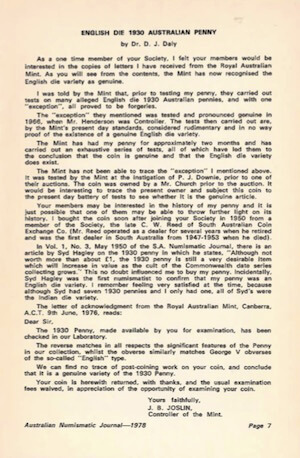
Daly advised readers of the SANJ that the RAM had recently authenticated his 1930 penny and that it had the London obverse. Daly stated that he “… bought the coin … in 1950 from a member of the Society, the late C. W, Reed of South Australian Coin Exchange Co.” Daly also advised that “Syd Hagley was the first numismatist to confirm that my penny was an English die variety.” [4]
Daly’s coin was the first London obverse 1930 penny ever offered to the collector market, when it was included in a Spink Australia auction in November 1978, where it sold for $3,800. This coin has appeared at auction several times since - in 1981; 1985; 2000; 2008 and 2015. It is now in the famed Benchmark collection and is regarded as the finest known example.
Example #3: Giles, Sourced Out Of London "In the Early 1980's"
The third known 1930 penny with the London obverse was bought by Murray Pearce out of London for Stuart Andersen in the early 1980s. It was sold to a Mr RJ Giles (a Victorian collector) and was subsequently sold by Noble Numismatics in their April 1998 sale. This coin was sold with a letter of authenticity from Royal Australian Mint, signed by J.B. Joslin dated 23 June 1981, as well as a letter of authenticity from E.G.V. Newman from the IBSCC dated 15th April 1981. This is known as the “Giles” coin. Images of the coin from the 1998 Noble catalogue show it to have a number of carbon spots either side.
Example #4: Harris, Last Seen in Sydney the 1990's
The fourth known 1930 penny with the London obverse was first handled by Darren Harris in the 1990s. Anecdotal discussions of the coin indicate it was in Fine condition, and that it had some surface damage. On that basis, there is a slim possibility it may be the Giles example - it has not been sighted on the open market since.
The above population shows that with just 3-4 examples known, the 1930 penny with the London obverse is Australia’s rarest circulating coin.
Unknown for nearly four decades, it was struck as part of a series of die experiments during the Great Depression. Due to the prevalence of counterfeit examples sighted over the years, it is a dangerous coin for a novice Australian collector to pursue.
A genuine example is worthy of inclusion in any of the finest collections of Australian coinage.
Credit / Acknowledgement:
The research for this article was the result of a great deal of co-operation from a range of numismatists. I'd like to credit the following people for support and help in preparing this article:
Stuart Andersen; Peter Andrews; David Briggs; Tony Byrne; Ken Downie; Darren Harris; Fred Lever; Neale Saliyb.
Our Other Articles About the 1930 Penny:
We've written several other articles that cover different aspects of the 1930 penny:
One of the very first questions that a new collector of Australian pre-decimal coins asks is: "Why is the 1930 penny Australia's most well-known rare coin?" Click this link to read our article that provides a good overview of Australia's most well-known rare coin.
One question that many novice collectors want to know is: "Why Is The 1930 Penny So Popular?" Click this link to read our article that explains just why it has remained popular ever since it was first discovered between 1940 and 1944.
One of the great mysteries that puzzles the average Australian coin collector is: "Why Is The 1930 penny So Rare?"Click this link to read our article that explains why so few of them were made during the darkest days of the Great Depression.
Footnotes:
[1] Hagley; Sid, "The 1930 Penny" in the South Australian Numismatic Journal, Volume 1, 1950, p 21.
[2] Beck; John, "New Variety of the 1930 Penny?" in the Australian Coin Review, Volume 3 Number 2, August 1966, p 5,31.
[3] Downie; Phil, "The Rise of the 1930 Penny" in the Australian Coin Review, Volume 3 Number 3, September 1966, p 5,7.
[4] Daly; Dr DJ, "English Die 1930 Australian Penny" in the Australian Numismatic Journal, 29, 1978, p 7.
Comments (1)
1930 Penny
By: Philip j Beeche on 9 October 2022Every time I read about the 1930 Penny more information comes to light. Well done by our researches.
